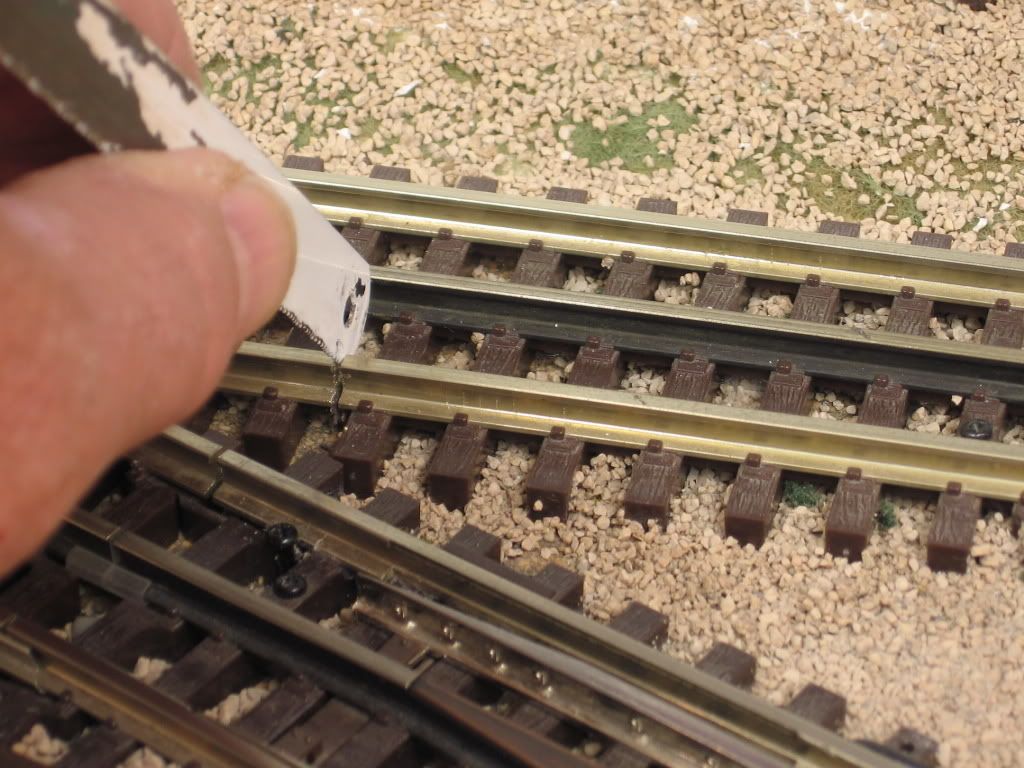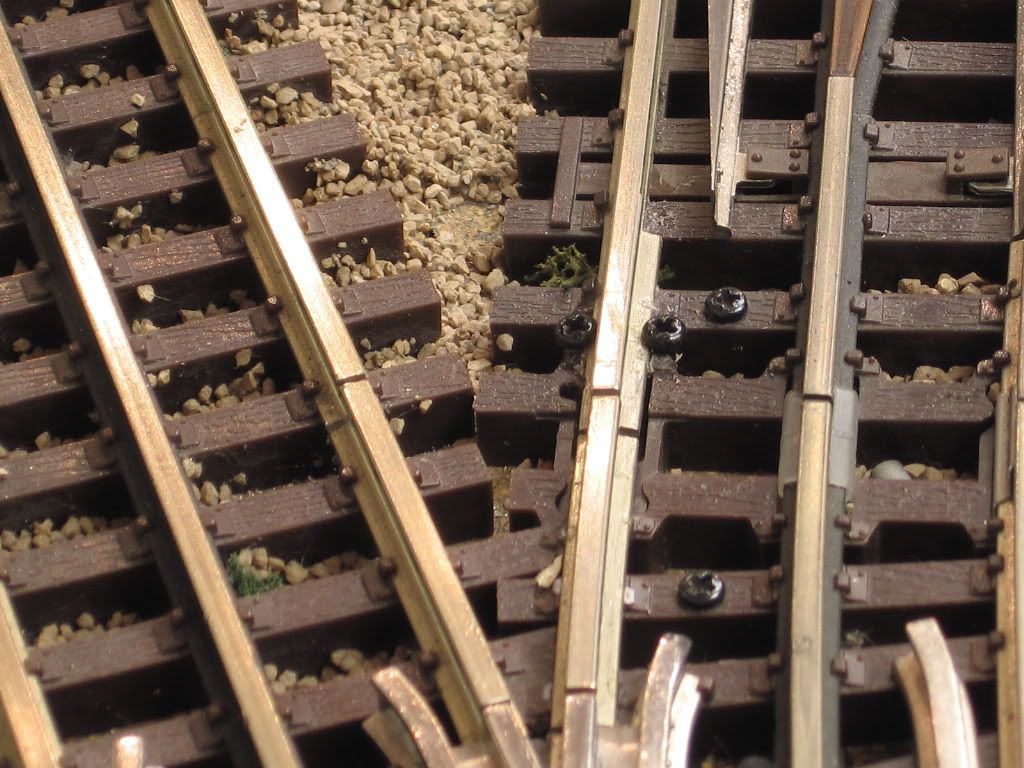I have just a simple oval of 0-54 track and thought I could add a siding with a left hand switch that has a small piece of center rail that has came loose. Even though the rail piece will slip back in the engines stall on the switch or just beyond. Looks like the wire connection to center rail is broken. I don't have a solder iron.
Replies sorted oldest to newest
If the adjoining track on that leg of the switch has power can't you just place a joiner there to carry the current into it?
That's what I thought but no, trains stall or stop.
Atlas sells rail joiners with wires all ready soldered to them.
I would still buy a soldering iron, also.![]()
I think the problem is it's a dead end for current on the right side of the little section of loose center rail where it meets the switch mechanism. Wired rail clips won't help that. There is a tiny bundle of wires that were soldered in to the short section of center rail at the factory. That looks like a challenging repair even with a solder iron. I am a little upset that I have 100 bucks invested in this switch and never used it yet,though I bought it about 5 years ago on eBay.
Johnny, bite the bullet and buy a soldering iron. Learn how to solder. Fix your switch instead of buying new. That’s the fun part of the hobby. The self accomplishment value that you receive will have you ready for the next problem that arises. Good luck.
This happens all the time with Atlas switches. The molded plastic spikes break off. Put a drop of super glue on 3 points. On the tie before the switch bar,and on the brace on each side of node that seats in the hole on the bottom of the rail. This should work for a while.
Thanks Rod I am looking at solder irons online. But still that little wire connection goes through a tie into the bottom of the rail and I don't know how I will solder something I can't even see when their placed together.
Thanks Glenn.
simple, this happens a lot like others have mentioned....first, lay the rail back where it belongs, from underneath, mark the spot where the wire goes to the rail with a silver sharpie, then take the rail back out, solder a piece of wire to the rail, then glue the rail back in place and attach the two wires together with a drop of solder....job done
Thanks Harmonyards.
Johnny, when you mark the rail, before you go to solder a leader onto it, scratch the bottom of the rail with a piece of scotchbrite or fine sandpaper ...sometimes it can be hard to get solder to flow onto the blackened rail....Ive been there done that!
You can usually attach the piece of track with CA. I also used Atlas track screws, one on each side of the piece that had come loose to secure it.
Screw just below my thumb.

Another view of the two screws holding the track in place.

Mike CT posted:You can usually attach the piece of of track with CA. I also used Atlas track screws, one on each side of the piece that had come loose to secure it.
Screw just below my thumb.
Another view of the two screws holding the track in place.
I like that fix!!!....great idea!!
Thank you so much Mike.
Johnny Winkler posted:Thank you so much Mike.
You're welcome. ![]()
![]()
I agree with those that suggested getting a soldering tool. How you have existed in this hobby without this valuable tool is beyond me. I have a number of pencil irons (30 to 60 watt size) a gun (150 and 250 watt ranges) but the most useful is my soldering station as you can dial in the heat you will need for the job. if you are soldering Atlas Rail get something that can generate a great deal of heat as the rail will dissipate the heat very quickly and prevent the solder from melting. Good Luck!
BobbyD posted:If the adjoining track on that leg of the switch has power can't you just place a joiner there to carry the current into it?
Johnny Winkler posted:That's what I thought but no, trains stall or stop.
That is not possible, if the track leading into the switch has power and you use a rail joiner to your loose segment it must have power. Now if you were transferring powerthru the switch to that adjacent track and it does not have a power feed that is something different.
These little problems and solving them are what makes this hobby so much fun. Sounds like you need to cobble together a basic tool kit.![]()
![]()
GLENN L. TAYLOR posted:This happens all the time with Atlas switches. The molded plastic spikes break off. Put a drop of super glue on 3 points. On the tie before the switch bar,and on the brace on each side of node that seats in the hole on the bottom of the rail. This should work for a while.
Super glue will NOT fix it. There is too much pressure from the rollers for super glue to hold. It's a simple fix. Search on this forum for my posts on how to fix Atlas o track with super glue and HO rail spikes. Once done that rail will not pop out again!
Thanks for the help everyone. I should have mentioned that I have never had a permanent o scale layout yet and I don't know a lot. The most I have done so far are temporary loops on folding tables in the garage,and that's only when it is cool in the fall and early winter. I guess you would call me more of a collector than actual model railroader.
.
BobbyD posted:BobbyD posted:If the adjoining track on that leg of the switch has power can't you just place a joiner there to carry the current into it?
Johnny Winkler posted:That's what I thought but no, trains stall or stop.
That is not possible, if the track leading into the switch has power and you use a rail joiner to your loose segment it must have power. Now if you were transferring powerthru the switch to that adjacent track and it does not have a power feed that is something different.
I guess what I did wrong was use the left hand turn out as part of my oval and the straight part of the switch as a stub end side track. This was never going to work without bus wiring both sides of the left hand switch in the oval? I think I will take down my setup and start all over when I have bus and feeder wire plus maybe a more powerful transformer than an MTH Z750.
Johnny:
the basic problem is not re-installing the the small rail. That can be done with CA as mentioned above. The issue is the connection from the small rail to the diverging center rails. With power connected to the diverging rails your locos will stop. As mentioned above once you get a solder iron a short piece of wire soldered to the side of the short rail to the side of the diverging rails will solve the problem.
Until then try this - cut a small piece of metal to act as a shim. When you glue in the short rail make sure the shim is thick enough to make contact between the short rail and the diverging rails then glue the short rail in place.
When you glue in the rail make sure no glue ends up on the switch bar. You absolutely do not want to glue the swicth bar to the short rail.
Joe
Johnny, I would not buy a soldering iron online. I recommend going to Lowes, Home Depot, or Menards and buying a Weller soldering gun kit, 100/135 watt I think is the rating. Easier to use than an iron, heats immediately, can handle soldering track.
"I guess what I did wrong was use the left hand turn out as part of my oval and the straight part of the switch as a stub end side track." Not a problem. It's done all the time.
Thanks Joe and RJR.


